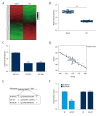Long Noncoding RNA Metastasis-Associated Lung Adenocarcinoma Transcript 1 (MALAT1) Promotes Renal Cell Carcinoma Progression via Sponging miRNA-429
- PMID: 29588438
- PMCID: PMC5887685
- DOI: 10.12659/MSM.909450
Long Noncoding RNA Metastasis-Associated Lung Adenocarcinoma Transcript 1 (MALAT1) Promotes Renal Cell Carcinoma Progression via Sponging miRNA-429
Abstract
Background: It is well known that long noncoding RNA (lncRNA) metastasis-associated lung adenocarcinoma transcript 1 (MALAT1) is closely correlated with the tumorigenesis of multiple cancers, including renal cell carcinoma (RCC). However, the potential functional mechanism is still elusive.
Material/Methods: In our present research, quantitative real-time polymerase chain reaction (qRT-PCR) was performed for the measurement of MALAT1 and miR-429. CCK-8 assay and Transwell assay were performed for the proliferation, migration, and invasion abilities of RCC cells. Dual-luciferase reporter assay was performed to validate the interaction within MALAT1 and miR-429.
Results: Data found that MALAT1 was overexpressed in RCC clinical samples and cell lines. Moreover, loss-of-functional experiments showed that MALAT1 knockdown suppress the proliferation, migration, and invasion abilities of RCC cells. RT-PCR showed that miR-429 expression was downregulated in RCC cell lines, which was negatively correlated with that of MALAT1. Bioinformatics analysis suggested that miR-429 had complementary binding sequences with MALAT1, which was confirmed by dual-luciferase reporter assay.
Conclusions: In summary, our results concluded that MALAT1 functioned as an oncogene in RCC by sponging miR-429, acting as its competing endogenous RNA (ceRNA).
Keywords: Carcinoma, Renal Cell; Nephrology; RNA, Long Noncoding.
Conflict of interest statement
None.
Figures




References
-
- Ljungberg BBK, Canfield S, Dabestani S, et al. EAU guidelines on renal cell carcinoma: 2014 update. Eur Urol. 2015;67:913–24. - PubMed
-
- Escudier BSC, Porta C, Gore M. Treatment selection in metastatic renal cell carcinoma: expert consensus. Nat Rev Clin Oncol. 2012;9:327–33. - PubMed
-
- Ljungberg B, Campbell SC, Choi HY. The epidemiology of renal cell carcinoma. Eur Urol. 2011;60:615–21. - PubMed
-
- Atkins MB, Ernstoff MS, Figlin RA, et al. Innovations and challenges in renal cell carcinoma: Summary statement from the Second Cambridge Conference. Clin Cancer Res. 2007;13:667–70. - PubMed
MeSH terms
Substances
LinkOut - more resources
Full Text Sources
Other Literature Sources
Medical
Molecular Biology Databases

